Diaphragm valves are used for the on/off and throttling of liquids that can carry a large number of suspended solids. The flexible membrane of the valve carries such operations. The flexible membrane is generally manufactured with an elastomer like Ebonite, Neoprene, Butyl, Hypalon, PP-HDPE, and PTFE. These are generally reinforced with metals.
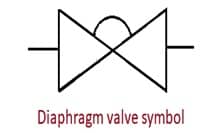
Diaphragm valves have linear motion characteristics. There is a separation between the fluid and parts of the operating mechanism. This makes them ideal for corrosive or viscous service since it avoids contamination to or from the outside.
A flexible membrane made of elastomer provides tightness. We can also reinforce the diaphragm with some metal. A linear movement axis punch tightens the shaft until it makes contact with the body. Thereby it acts as a seat.
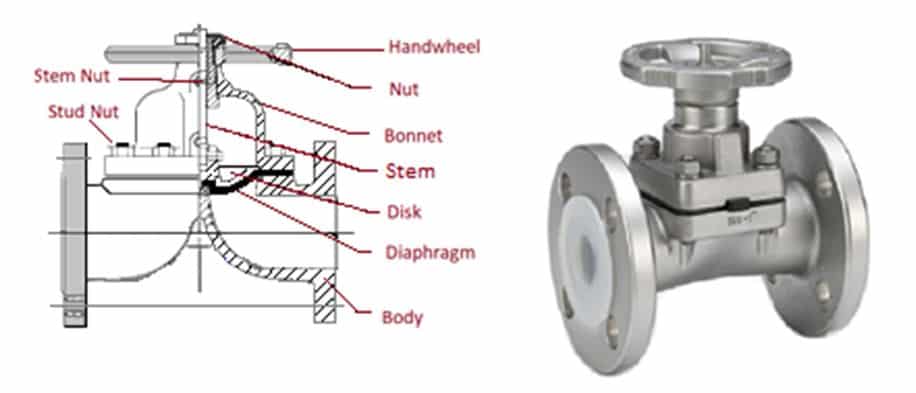
The applications of diaphragm type of valve are mainly for low pressures and watered–down pates that would corrode and clog most other equipment. They are fast opening.
To comply with these operations, the valve stem rises or falls in a linear way up to the tension point of the membrane until it comes into contact with the seal of the valve body in the lower part of the same, producing the total closure of the valve.
As shown in the below figure, the diaphragm valve has a stem that from a distance also serves to know if it is open (stem up) or closed (stem down).
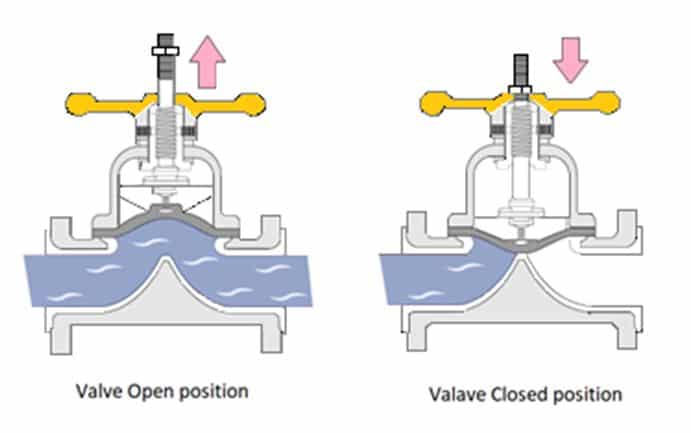
Types of Diaphragm Valves
There are two types of diaphragm valves
- Weir type diaphragm valve
- Straightway diaphragm valve.
The function of both types of valves is similar. but only differ in their body shape, diaphragm, and application.
Weir Type Diaphragm Valve (Restricted Passage)
The weir-type diaphragm valves as shown in the below figure, have a raised seat that the diaphragm comes in contact with. This type of valve is best suitable for clean fluids, less suitable for slurry and viscous flow, may buildup either side instead of complete draining. We can use this type of diaphragm valve in the opening, closing, and regulating services.
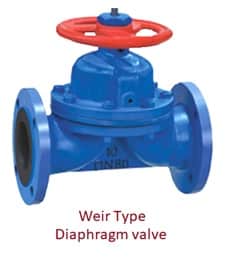
Straightway Type Diaphragm Valve (Direct Pass)
We use the straightway type diaphragm Valve for open and close service. We call this type of valve a Straight-Thru. It is an extension of the pipeline and a practical solution to the problem of plugging, contamination, and abrasion it characteristics are minimal pressure drop, no cavities, bidirectional flow, self-draining.
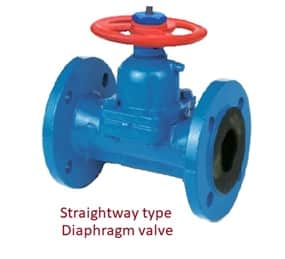
General Operation and Maintenance instructions
- Valves and their components can get damaged if operated outside the pressure range for which they were designed.
- When determining the materials of the valve components, the chemical fluids that will pass through it must be taken into account, to be compatible and avoid damage.
- Check the valve hardware during maintenance, as over time they tend to loosen.
- Excessive force must not be used to open or close the valve while hand-wheel operation.
Specifications for the Order
- Diaphragm material
- Bonnet type.
- Type of operation.
- Working pressure.
- Operating temperature.
- Stem type.
- Body material.
General Ratings and Features of Diaphragm Valve
Typical Diaphragm Size
Generally Diameter size range: from 0.5 up to 14”.
Pipe Connection
Threaded, butt-weld, clamp, flange, socket, and spigot welded.
Diaphragm Materials
Buna N (Nitrile Butadiene Rubber), Butyl Rubber (IIR), Ethylene Propylene (EPDM), Hypalon (CSM), Natural Rubber (NR), Neoprene (CR), PTFE with EPDM backing, and Viton (FKM). Leather, Silicon Rubber,
Body
Cast Iron, Cast steel, Bronze, SS 304/316, Aluminum, PVC, PP, Polypropylene.
Body Lining
Neoprene, EPDM, Viton, Ebonite, Silicon, PTFE (Poly Tetra Fluor Ethylene).
Temperature Range
Depending on the diaphragm material, the temperature range can be -10°C (-14° F) to + 170 ° C (+ 350 °F).
Pressure Range
Depending on the material.
Applications of Diaphragm Valve
They are used in many industries because it is cheap, effective, and available in many varieties. The followings are some common sectors where diaphragm valves have its widespread use.
- Sewage plant
- Pharmaceutical industries
- Food processing units
- Chemical processing units
- Mine sector
- boiler condensate treatment
- water treatment plants
- Power industries
- Vacuum services
- Breweries
- Corrosive applications
The fluid remains never in contact with the valve components because the valve membrane keeps the fluid separate from the valve components. Therefore, these valves are most suitable for viscous or corrosive fluids.
Advantages of Diaphragm Valve
- The cost of the valve is usually low.
- Diaphragm valve is suitable for throttling application.
- For controlling the small flow, a weir-type diaphragm valve is suitable.
- The throttling characteristics of diaphragm valves are fit for a quick opening valve because it has large shutoff area along the seat.
- The fluids do not come in the contact with the valve components. It has no packaging. Thus, the operating mechanism of a diaphragm valve does not expose to the media within the pipeline. Also, the sticky or viscous fluids can not enter into the bonnet. Thus the fluid media does not interfere with the operating mechanism.
- They are most suitable for the handling of corrosive fluids, fibrous slurries, radioactive fluids.
- It delivers bubble-tight service.
- The probability of leaks is almost nil.
- Minimal pressure loss, and extreme safety.
- Many fluids have tendency to clog , corrode, or gum up the operating parts. However, the fluid passes through a diaphragm valve without causing problems. This is because the fluid stagnation does not occur. Therefore, the clogging is minimal in a diaphragm valve.
- There is a little pressure /head loss.
- These valves don’t contain pockets for trapping contaminations.
Disadvantages of Diaphragm Valve
- Excessive use of force could damage the diaphragm.
- Valve transition has sets that prevent complete discharge of the pipeline.
- The diaphragm material has operation constraint with a temperature and pressure. We can use the diaphragm material under 200 psi (14 bar) pressure and up to 204ºC temperature. Operation beyond this pressure and temperature range may cause damage to diaphragm.
- Require more maintenance because of diaphragm wear.
- Not advisable for high-pressure applications, and valve is not suitable for very high-pressure applications (more than 300 psi).
- Open and close operation is a bit slow.
- The hydrostatic pressure that can be applied to the diaphragm is limited.
- There is a limit on the dimensions of diaphragm valves. They are produced in DN15-DN300 dimensions.
- The diaphragm can corrode if frequently used for heavy throttling services with contamination.
- Not best suitable for multi-turn operations.
Read Next:
My doubts are cleared by reading this article
Thank you for your efforts